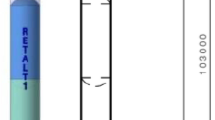Abstract
The trajectories of a mission to an asteroid with the presence of a spacecraft (SC) near the asteroid for some time and including a return to the Earth have been studied. A two-stage method of constructing optimum (with respect to the maximum of the useful SC mass) interplanetary trajectories for an Earth–asteroid–Earth mission with high thrust engines has been developed: in the central Newtonian field of the Sun’s attraction at the first stage and with allowance for perturbations at the second stage. An algorithm of constructing conjugate functions for the case of maximizing the useful mass has been designed. The optimum trajectories for the Earth–Apophis–Earth mission have been constructed and analyzed. The possibility in principle of organizing the Earth–Apophis–Earth space mission based on the Soyuz and Zenit launch vehicles and Fregat upper stage for a flight in 2019–2022 has been demonstrated.



Similar content being viewed by others
REFERENCES
K. E. Tsiolkovsky, Exploration of Cosmic Space by Means of Reaction Devices, in Pioneers of Rocket Engineering: Kibalchich, Tsiolkovsky, Tsander, and Kondratyuk. Selected Papers (Nauka, Moscow, 1964) [in Russian].
S. A. Sandford, Proc. Int. Astron. Union 7 (S280), 275 (2011).
T. Ajluni, D. Everett, T. Linn, et al., OSIRIS-REx, Returning the Asteroid Sample, in 2015 IEEE Aerospace Conference, pp. 1–15.
Automatic Spacecrafts for Fundamental and Applied Scientific Investigations, Ed. by G. M. Polishchuk and K. M. Pichkhadze (MAI-PRINT, Moscow, 2010) [in Russian].
V. V. Ivashkin and A. Lang, Dokl. Phys. 61, 288 (2016).
V. V. Ivashkin and A. Lang, Cosmic Res. 55, 253 (2017).
W. Hohmann, Die Erreichbarkeit der Himmelskörper (R. Oldenbourg Verlag, München, 1926).
V. A. Il’in and G. E. Kuzmak, Optimum Flights of Spacecraft with High Thrust Engines (Nauka, Moscow, 1976) [in Russian].
I. M. Sobol’ and R. B. Statinkov, The Choice of Optimum Parameters in Multicriteria Problems (Nauka, Moscow, 1981) [in Russian].
T. V. Panchenko, Genetic Algorithms: a Study Guide (Astrakhan University, Astrakhan, 2007) [in Russian].
J. Nocedal and S. J. Wright, Numerical Optimization, 2nd ed. (Springer, 2006).
V. V. Ivashkin and A. Lang, Preprint No. 113, KIAM RAS (Keldysh Institute of Applied Mathematics, Russian Academy of Sciences, 2017).
M. E. Abbasov, Optimization Methods (VVM, St. Petersburg, 2014) [in Russian].
Author information
Authors and Affiliations
Corresponding author
Additional information
Translated by A. Nikol’skii
Rights and permissions
About this article
Cite this article
Ivashkin, V.V., Lang, A. Optimum Trajectories for an Earth–Asteroid–Earth Mission with a High Thrust Flight. Dokl. Phys. 64, 14–19 (2019). https://doi.org/10.1134/S102833581901004X
Received:
Published:
Issue Date:
DOI: https://doi.org/10.1134/S102833581901004X




